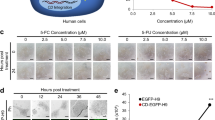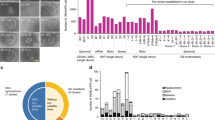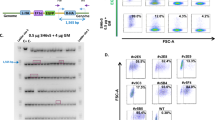Abstract
We report a simple method, using p53 suppression and nontransforming L-Myc, to generate human induced pluripotent stem cells (iPSCs) with episomal plasmid vectors. We generated human iPSCs from multiple donors, including two putative human leukocyte antigen (HLA)-homozygous donors who match ∼20% of the Japanese population at major HLA loci; most iPSCs are integrated transgene-free. This method may provide iPSCs suitable for autologous and allologous stem-cell therapy in the future.
This is a preview of subscription content, access via your institution
Access options
Subscribe to this journal
Receive 12 print issues and online access
$259.00 per year
only $21.58 per issue
Buy this article
- Purchase on Springer Link
- Instant access to full article PDF
Prices may be subject to local taxes which are calculated during checkout



Similar content being viewed by others
References
Okita, K., Ichisaka, T. & Yamanaka, S. Nature 448, 313–317 (2007).
Zhou, W. & Freed, C.R. Stem Cells 27, 2667–2674 (2009).
Fusaki, N., Ban, H., Nishiyama, A., Saeki, K. & Hasegawa, M. Proc. Jpn. Acad. B 85, 348–362 (2009).
Woltjen, K. et al. Nature 458, 766–770 (2009).
Jia, F. et al. Nat. Methods 7, 197–199 (2010).
Yu, J. et al. Science 324, 797–801 (2009).
Kim, D. et al. Cell Stem Cell 4, 472–476 (2009).
Warren, L. et al. Cell Stem Cell 7, 618–630 (2010).
Hong, H. et al. Nature 460, 1132–1135 (2009).
Nakagawa, M., Takizawa, N., Narita, M., Ichisaka, T. & Yamanaka, S. Proc. Natl. Acad. Sci. USA 107, 14152–14157 (2010).
Tamaoki, N. et al. J. Dent. Res. 89, 773–778 (2010).
Nakatsuji, N., Nakajima, F. & Tokunaga, K. Nat. Biotechnol. 26, 739–740 (2008).
Tsuji, O. et al. Proc. Natl. Acad. Sci. USA 107, 12704–12709 (2010).
Takemoto, S.K., Terasaki, P.I., Gjertson, D.W. & Cecka, J.M. N. Engl. J. Med. 343, 1078–1084 (2000).
Aydingoz, S.E. et al. Hum. Immunol. 68, 491–499 (2007).
McMahon, A.P. & Bradley, A. Cell 62, 1073–1085 (1990).
Takahashi, K. et al. Cell 131, 861–872 (2007).
Niwa, H., Yamamura, K. & Miyazaki, J. Gene 108, 193–199 (1991).
Okita, K., Nakagawa, M., Hyenjong, H., Ichisaka, T. & Yamanaka, S. Science 322, 949–953 (2008).
Morizane, A., Doi, D., Kikuchi, T., Nishimura, K. & Takahashi, J. J. Neurosci. Res. 89, 117–126 (2010).
Kawasaki, H. et al. Proc. Natl. Acad. Sci. USA 99, 1580–1585 (2002).
Osakada, F. et al. J. Cell Sci. 122, 3169–3179 (2009).
Itoh, Y. et al. Immunogenetics 57, 717–729 (2005).
Acknowledgements
We thank K. Takahashi, T. Aoi and Y. Yoshida for scientific discussion; M. Narita, T. Ichisaka, M. Ohuchi, M. Nishikawa and N. Takizawa for technical assistance; R. Kato, E. Nishikawa, S. Takeshima, Y. Ohtsu and H. Hasaba for administrative assistance; and H. Niwa (RIKEN) and J. Miyazaki (Osaka University) for the CAG promoter. This study was supported in part by a grant from the Program for Promotion of Fundamental Studies in Health Sciences of National Institute of Biomedical Innovation, a grant from the Leading Project of Ministry of Education, Culture, Sports, Science and Technology (MEXT), a grant from Funding Program for World-Leading Innovative Research and Development on Science and Technology (FIRST Program) of Japan Society for the Promotion of Science, Grants-in-Aid for Scientific Research of Japan Society for the Promotion of Science and MEXT (to S.Y.) and Senri Life Science Foundation (to K.O.). H.H. is supported by a Japanese government (MEXT) scholarship.
Author information
Authors and Affiliations
Contributions
K.O. and S.Y. conceived the project and wrote the manuscript. K.O. constructed the vectors with H.H., M.N. and K. Tanabe, and conducted most of the experiments with Y.M., Y. S. and A.O. A.M. and J.T. carried out the differentiation experiment into dopaminergic neurons. S.O. and M.T. performed differentiation into retinal pigment epithelial cells. K. Tezuka., T.S. and T.K. established dental pulp cell lines. H.S. performed HLA haplotyping in Japanese population and supervised HLA analysis.
Corresponding authors
Ethics declarations
Competing interests
K.O., M.N. and S.Y. are filing a patent application to Japan, US and EU based on the results reported in this paper (PCT/JP2010/063733). S.Y. is a member of Scientific Advisory Board for iPS Academia Japan Inc. and iPierian Inc., which manage the patents.
Supplementary information
Supplementary Text and Figures
Supplementary Figures 1–9 and Supplementary Tables 1–7 and 9, 10 (PDF 1911 kb)
Supplementary Table 8
Haplotype frequency for HLA-A, HLA-B and HLA-DRB1 loci in Japanese population. (XLS 395 kb)
Rights and permissions
About this article
Cite this article
Okita, K., Matsumura, Y., Sato, Y. et al. A more efficient method to generate integration-free human iPS cells. Nat Methods 8, 409–412 (2011). https://doi.org/10.1038/nmeth.1591
Received:
Accepted:
Published:
Issue Date:
DOI: https://doi.org/10.1038/nmeth.1591
This article is cited by
-
Pre-clinical evaluation of the efficacy and safety of human induced pluripotent stem cell-derived cardiomyocyte patch
Stem Cell Research & Therapy (2024)
-
Epigenetic regulation and factors that influence the effect of iPSCs-derived neural stem/progenitor cells (NS/PCs) in the treatment of spinal cord injury
Clinical Epigenetics (2024)
-
Integration-free induced pluripotent stem cells from three endangered Southeast Asian non-human primate species
Scientific Reports (2024)
-
WNT signalling control by KDM5C during development affects cognition
Nature (2024)
-
Serotonin effects on human iPSC-derived neural cell functions: from mitochondria to depression
Molecular Psychiatry (2024)



